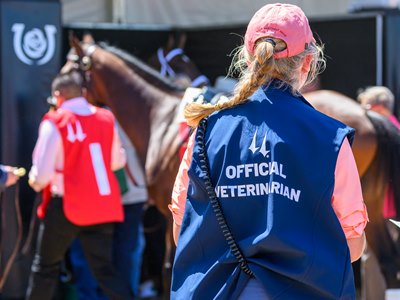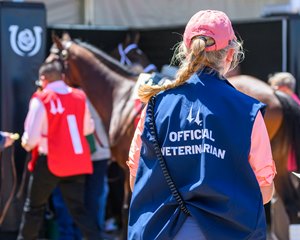Declining Number of Equine Vets a Cause for Concern


The world of equine medicine is facing a crisis and if steps aren't taken soon to correct the course, the damage may be beyond repair.
For years, the number of equine veterinarians has been declining, creating a shortage of practitioners that the industry is feeling the effects of today.
American Association of Equine Practitioners (AAEP) executive director David Foley said his organization noticed the downward trend about five or six years ago.
"The best way for me to measure that is just based on membership numbers," he said. "It's been pretty flat for a few years now. I mean, we have many, many members, new members join every year. And then we lose a lesser percentage. But then we have an aging population of (our) membership as well. ... And then we started really hearing from our practices. And so that really got our attention."
The factors that contribute to the decline are complex. Beyond aging, other components include education, compensation, and the need for awareness of the different career paths that are available.
"The cost of the education has just skyrocketed," said Dr. Mary Scollay, the Horseracing Integrity & Welfare Unit chief of science. "It is not unusual for students to graduate with $300,000 or more in debt (from) student loans between undergraduate and vet school. And what veterinarians make when they graduate, it is a very daunting prospect the thought of paying that off over decades. It makes it hard for them to contemplate owning a practice; it makes it hard for them to contemplate owning a home. That's challenging."

According to U.S. News & World Report data, an in-state undergraduate degree in 2022-23 costs $22,953. Meanwhile, a 2020 Nerd Wallet report states that an in-state doctorate in veterinary medicine costs as much as $247,455. All told, a student could spend nearly $340,000.
Then, upon graduating and having to carry the debt, trying to strike a work-life balance becomes just as difficult. If someone takes a job at a track, their day starts before sunrise and can run until after racing is completed for the day—or night.
Scollay suggested industry stakeholders—tracks, racing commissions, racing associations, and large breeders—find creative ways to bring in and retain new talent. One such method would be subsidizing a portion of the educational costs in exchange for x-number of years of commitment.
Though even if the industry could get an injection of youth, getting a younger generation to stick around is another challenge.
Scollay said small animal practices have long noticed the need for work-life balance. That sector has taken measures such as four days on, three days off, but unlike their equine counterparts, small animal veterinarians have emergency clinics.
The AAEP's Foley said, "I think older practitioners who were used to working six, seven days a week, that's just what you did, and the younger members expect to have more balance in their life and I really can't say that they're wrong in doing so."
The need to find solutions to the decline in equine veterinarians is new. New problems require new answers.
"Those of us who've been around a long time, only have a certain mindset and don't really know how to adapt to maybe hiring two veterinarians to do the job as one so that there is personal time, so there is time to drop the kids off at school, pick them up, go to ball games, not feeling like you have to make a decision between a family and a job," said Scollay.
She added, "We've got to stop referencing, 'Well, when I was young.' ... That's not a marketable premise anymore."
Through surveys, the AAEP sought to understand what the pain points were for the different demographics of its membership. The results led the AAEP to form a commission on equine veterinary sustainability last year. Within the committee were five subcommittees focusing on specific factors: compensation, emergency coverage, student outreach, internships, and practice culture.

Foley said these efforts are already beginning to produce results.
"It certainly won't get fixed overnight, and we're seeing practices kind of adapt some of their models," he said. "I heard from a racetrack practice (that) thanked us for our work that they've been able to successfully hire four new associates."
Part of the battle, according to Foley, is being a "mythbuster" of information that the AAEP believes is either wrong or not as concise as possible.
For example, he said the American Veterinary Medical Association had released information that showed equine starting salaries at approximately $56,000 while those specializing in small animals were almost double at $110,000. Foley said that what the AVMA didn't include was the compensation for doing emergency work, which brings that number closer to $89,000 for equine vets.
He added that the AVMA data is what is pushed out into the veterinary schools and colors the perception of students looking to start their careers. And many vet schools don't discuss the various career opportunities that exist, specifically for those wanting to work with horses.
"Many of my classmates are not doing that thing, whatever it was they went to vet school saying, 'I'm going to do this and nothing else.' And certainly, I'm one of them. I never contemplated regulatory medicine. And so, I think that stronger candidates now are the ones that show that you have a broader understanding of what the profession really means."
Calls to several top-ranked veterinary programs in the United States were not returned.
The AAEP has student chapters at many colleges and universities and is encouraging equine practitioners to meet with these students about how they can have successful careers. There are other programs such as Amplify Horse Racing, which pairs industry professionals with young adults who have an interest in careers in Thoroughbred horse racing.
Scollay said one of her mentees, a sophomore in high school, came to Keeneland from Tennessee and a practicing veterinarian offered her a job upon completing her education.
The declining number of qualified veterinarians is being felt at the track.
"We've heard from reports around the country, particularly the racetracks, that they're really having difficulty and you know, not only racetrack practitioners but regulatory veterinarians as well, that they're really having issues finding people to work. So we're hearing that a lot more now than we ever have," Foley said.
Scollay was recently at a track where there was one practicing veterinarian for the entire population at that location.
"I know that a lot of my colleagues are tired," Scollay said. "I know a lot of my colleagues are frustrated. I know they're having really long days. (But) I'm not seeing them walk away."
How can the tide be turned and attract younger people to the profession?
"There is very little in the way of health insurance for animals, and so, animal health care is typically a direct out-of-pocket expense for the owner," Scollay said. "To adequately compensate somebody who's had eight years of college not that dissimilar from a human medical degree, where does the money come from without harming the pet owner or harming pets? Because there's certainly a great expectation that veterinarians love animals and will do whatever they can to help an animal independent of what it actually costs to do that. And that has created pressure, tremendous stress for a lot of veterinarians who feel an obligation to the animal."
Both Foley and Scollay said it's not too soon to sound the alarm on the concerns facing the industry. Not too dissimilar to environmentalists who raise concerns and recognize the need for change before there is a doomsday clock-type scenario with a point of no return.
"I think we're close to there. ... But I think some tracks are already there," Scollay said.
